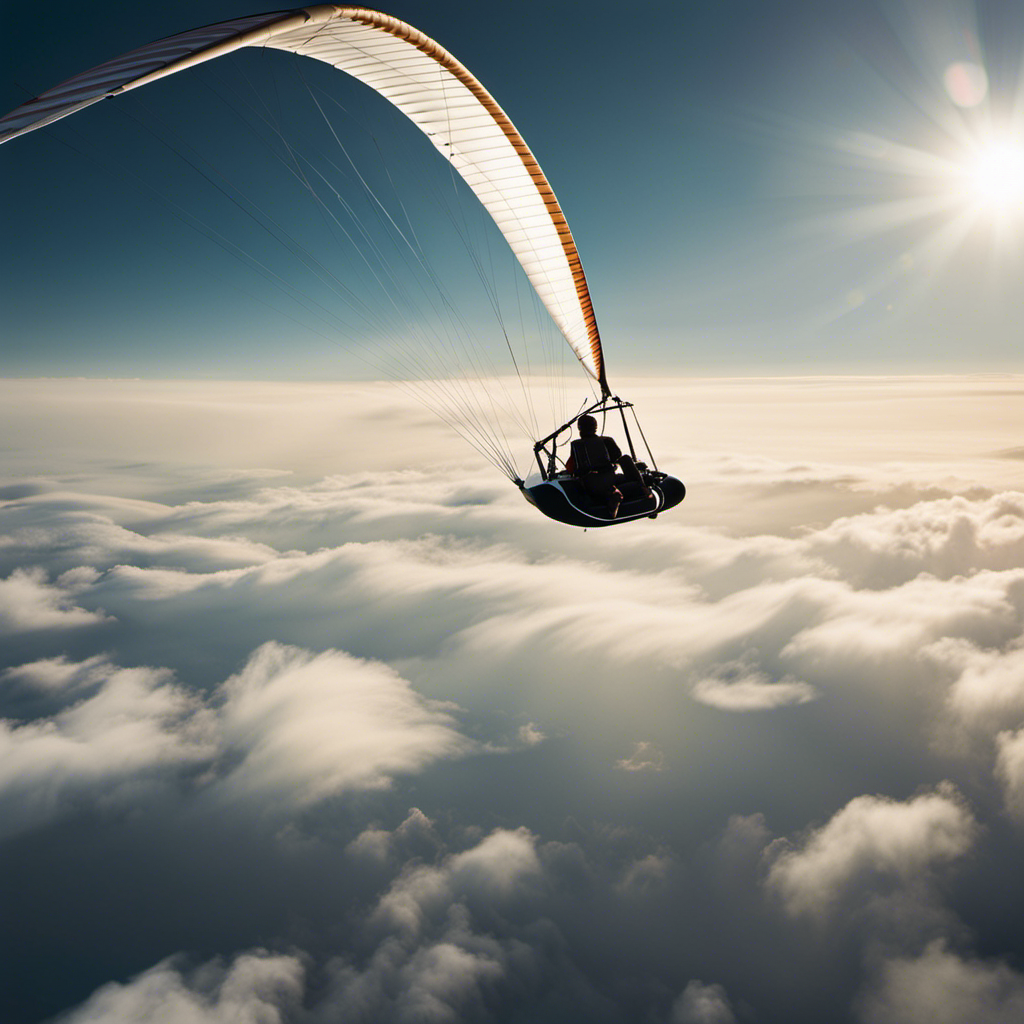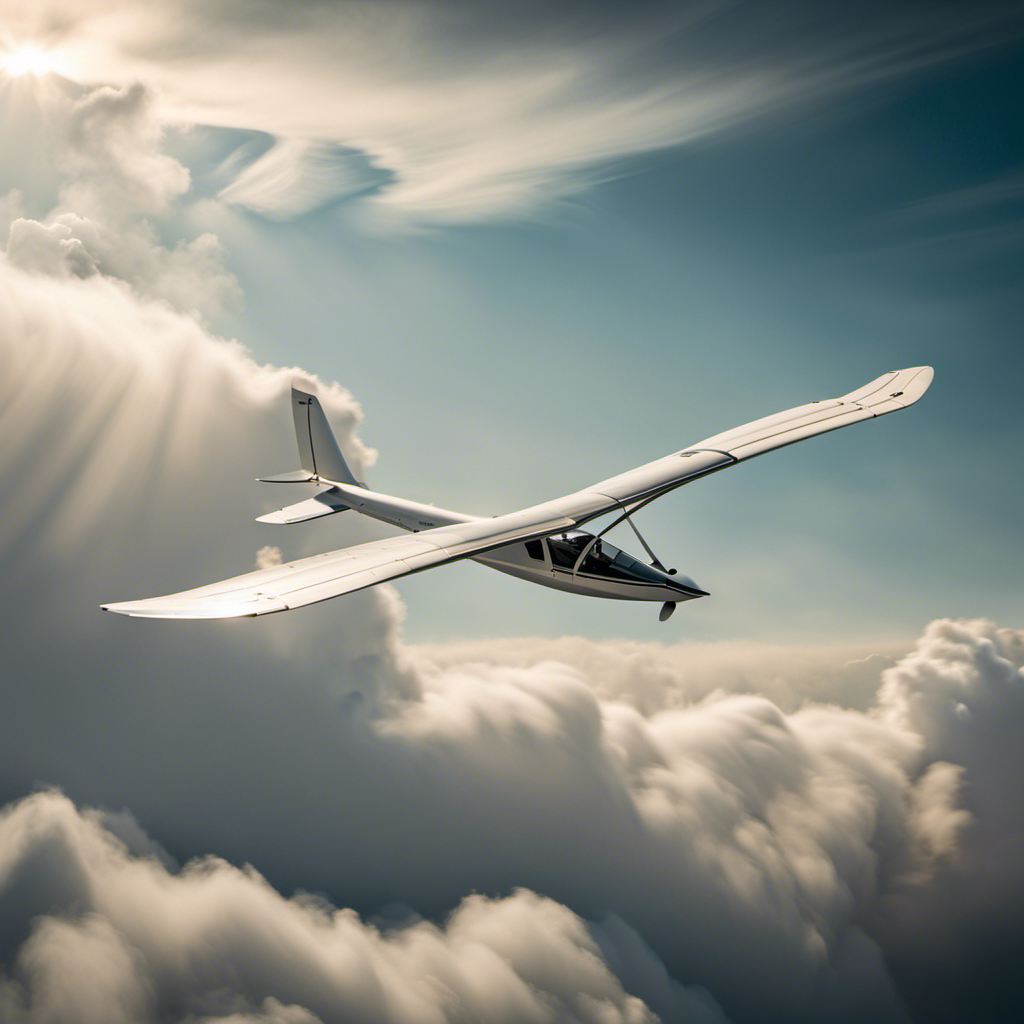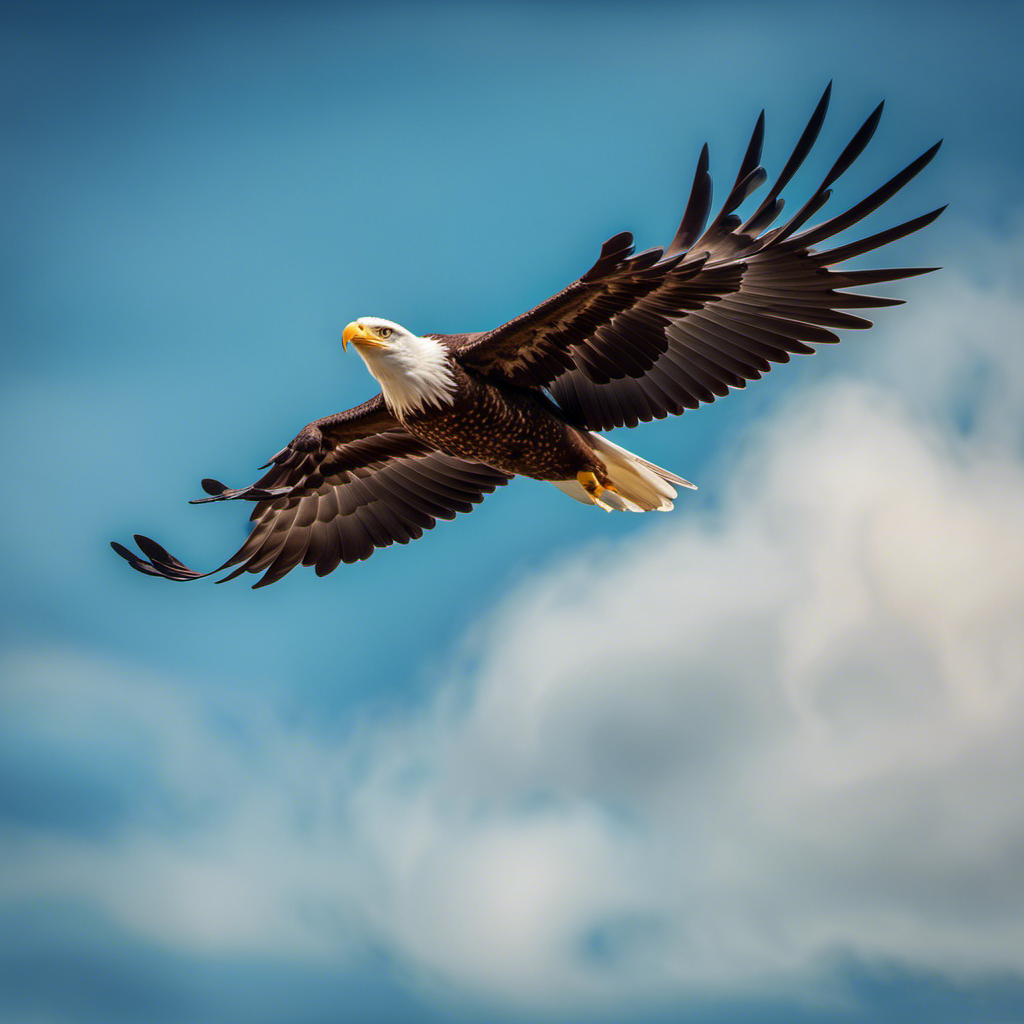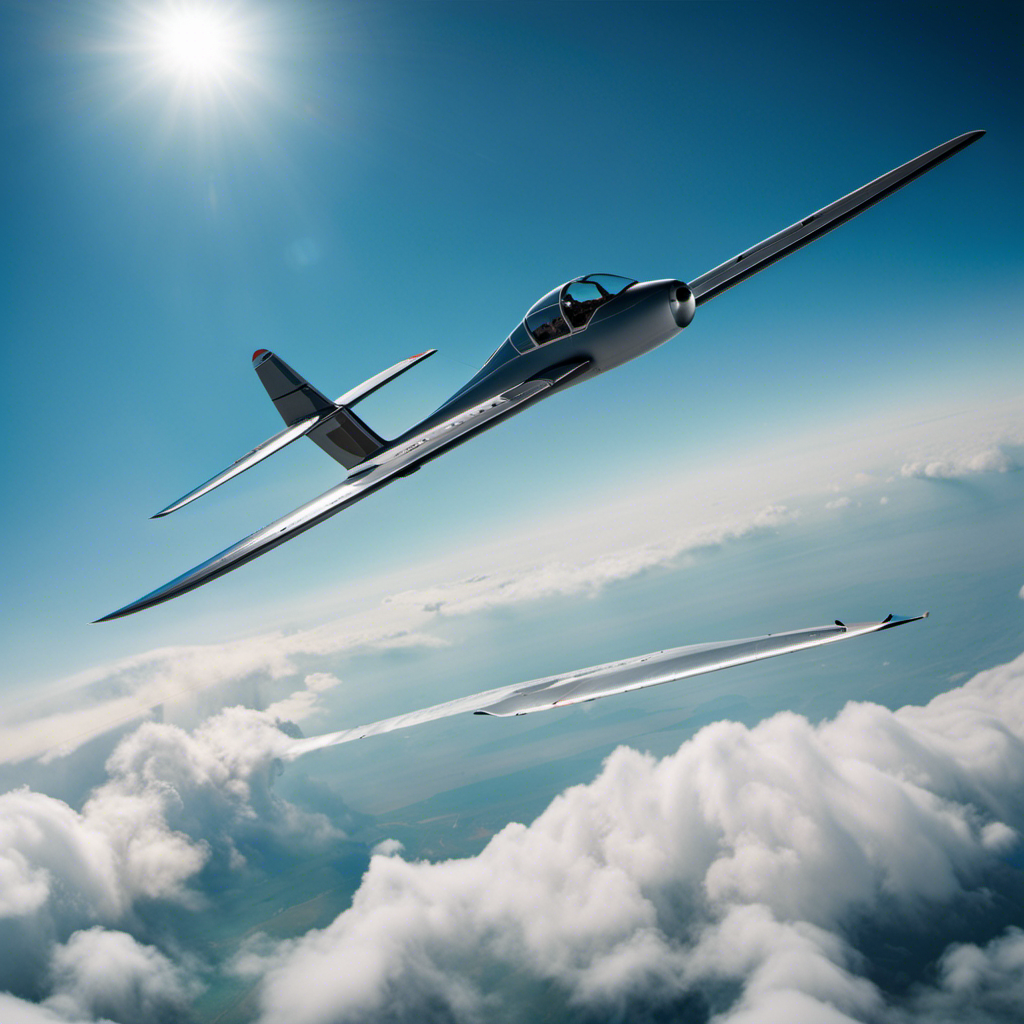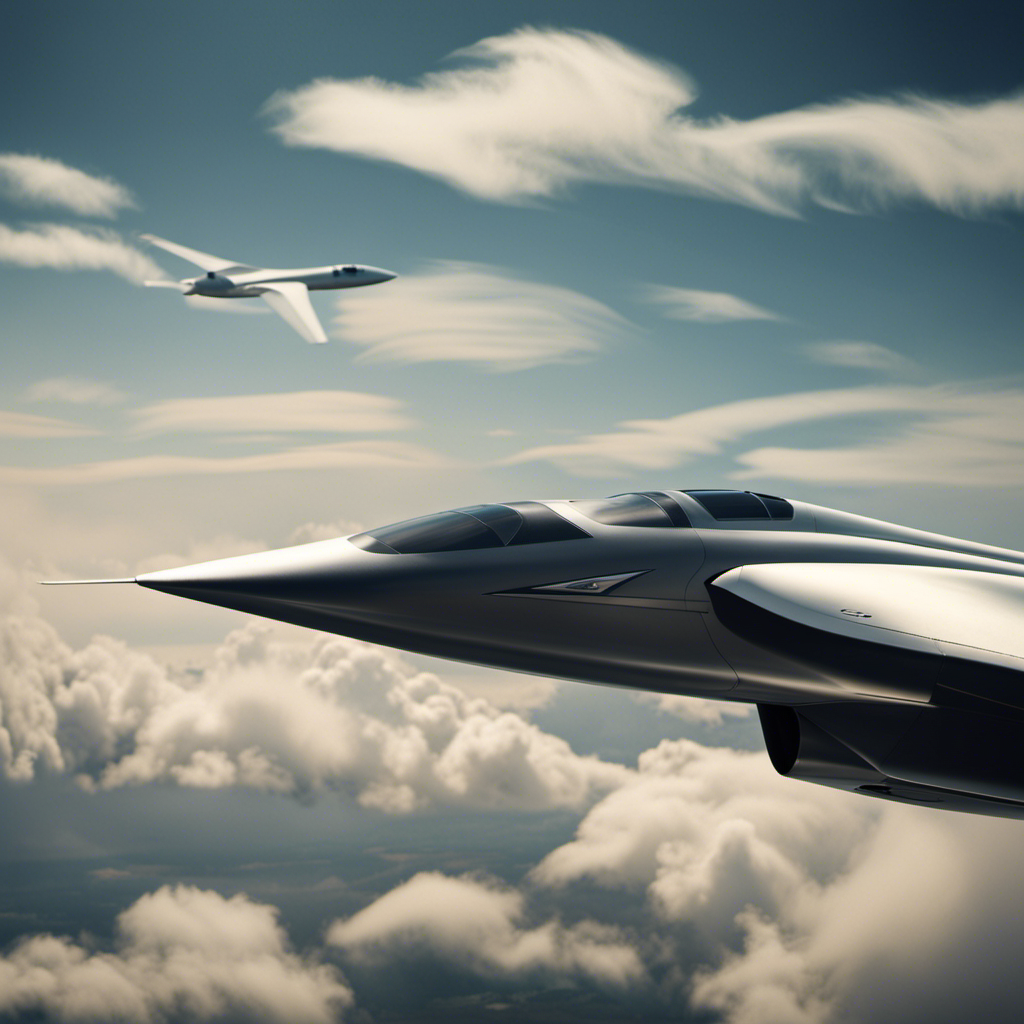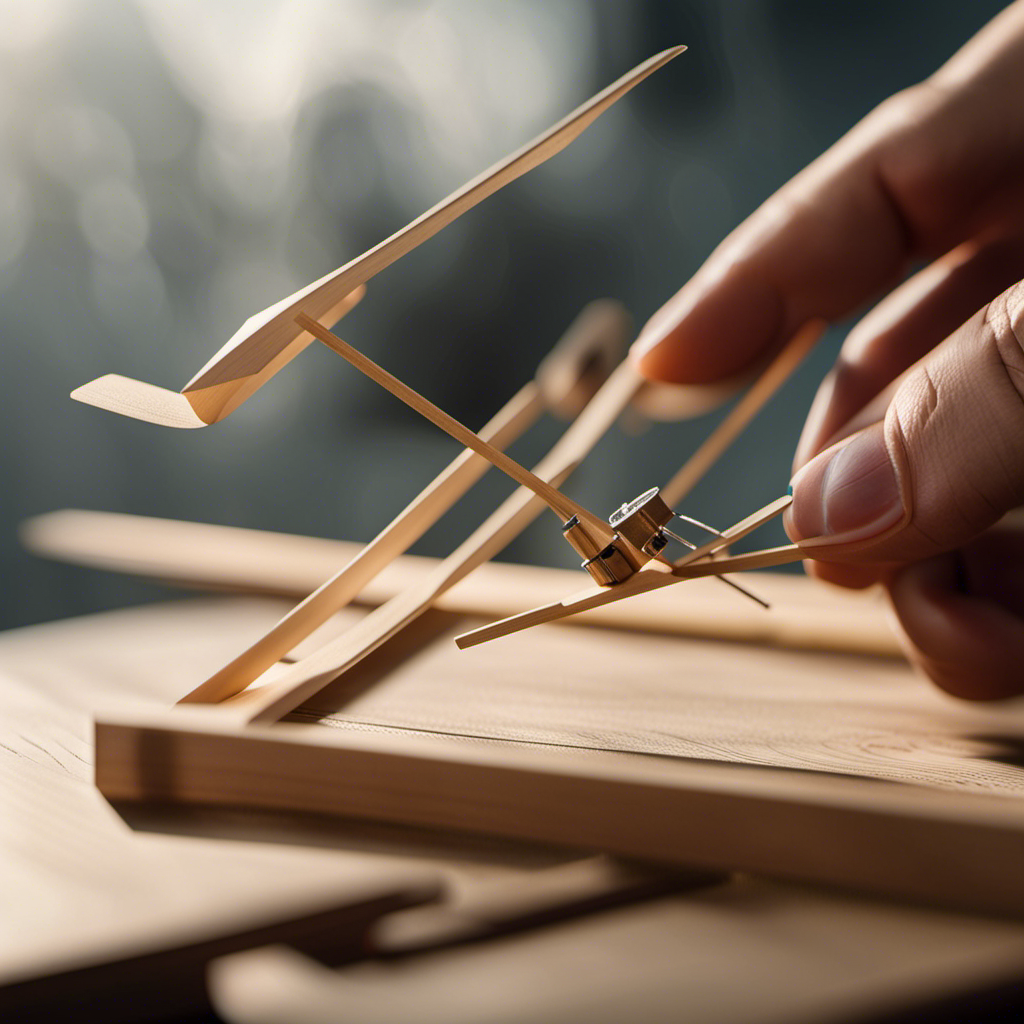I soar in gliders, and I can guarantee you that gliding through the sky is like dancing with the wind. This article seeks to reveal the rich history of glider flying and will give a glimpse into the core principles of glider flight.
I’ll share tips on choosing the perfect glider for your needs and guide you through the essential skills of piloting. We’ll also discuss safety measures, different types of glider flying, and opportunities to join a vibrant glider community.
So strap in and get ready to merge your passion for flight with the skill of glider piloting.
Key Takeaways
- Glider flying has a rich history and has been influenced by notable figures such as Otto Lilienthal and the Wright brothers.
- Factors like glider selection, maintenance, and customization play a crucial role in ensuring a safe and personalized flying experience.
- Piloting skills, safety measures, and adherence to regulations are essential for a successful glider flying experience.
- Glider flying offers various opportunities for exploration and personal growth, while advancements in technology contribute to the future of the sport.
The History of Glider Flying
The history of glider flying can be traced back to the early 19th century. During this time, humans began experimenting with the concept of soaring through the air without an engine. The evolution of glider design was a gradual process, with each iteration building upon the knowledge and experience gained from previous attempts.
Notable figures in glider flying history include Otto Lilienthal, a German aviation pioneer who made significant contributions to the field. Lilienthal’s glider designs were based on meticulous observations of bird flight, and he conducted numerous successful flights in the late 1800s.
Another key figure is the Wright brothers, Orville and Wilbur, who are credited with making the first controlled, powered flight in 1903. While their aircraft was not a glider per se, their understanding of aerodynamics and flight principles played a crucial role in the development of glider designs.
Understanding the basics of glider flight requires a grasp of aerodynamics, weight and balance, and control surfaces. By harnessing the forces of lift, drag, and gravity, glider pilots are able to navigate the skies with grace and precision.
Understanding the Basics of Glider Flight
Understanding the basics of glider flight is essential for pilots. As someone who has spent countless hours soaring through the sky, I have come to appreciate the intricacies of glider aerodynamics and the incredible maneuvers that can be achieved with these aircraft.
Here are some key points to consider when it comes to glider flight:
-
Lift: Gliders rely on the upward force of lift to stay airborne. This lift is generated by the airflow over the wings, which creates a pressure difference between the upper and lower surfaces of the wing.
-
Drag: Drag is the resistance encountered by the glider as it moves through the air. Minimizing drag is crucial for achieving maximum glide performance and efficiency.
-
Weight and Balance: Proper weight distribution and balance are essential for safe and stable flight. Pilots must carefully manage the positioning of passengers, cargo, and ballast to ensure the glider remains stable and controllable.
When it comes to advanced glider maneuvers, skilled pilots can push the limits of what these aircraft are capable of. From aerobatic maneuvers like loops and rolls to advanced soaring techniques such as ridge and wave soaring, there is always something new to learn and master in the world of glider flying.
As we delve deeper into the world of glider flight, it becomes apparent that choosing the right glider for you is a crucial decision.
Choosing the Right Glider for You
As you delve deeper into the world of glider flight, it becomes apparent that choosing the right glider for you is a crucial decision. Glider maintenance and customization are key considerations when making this choice. To help you understand the various options available, I have created a table below that outlines some important factors to consider:
| Factor | Importance |
|---|---|
| Wingspan | High |
| Wing Loading | Medium |
| Glide Ratio | High |
| Cockpit Size | High |
| Control Sensitivity | Medium |
When it comes to glider maintenance, it is essential to regularly inspect and service your aircraft. This includes checking the control surfaces, inspecting the airframe for any signs of damage, and ensuring that the parachute system is in good working order. Additionally, glider customization allows you to personalize your aircraft to suit your specific needs and preferences. This can involve adding instruments, such as a variometer or GPS, or making modifications to improve performance, such as installing winglets or a retractable landing gear.
Learning the Essential Skills of Glider Piloting
Once you’ve chosen the right glider, it’s time to start learning the essential skills of piloting. As a glider pilot, mastering maneuvers and advanced glider techniques is crucial for a safe and exhilarating flight experience.
One of the first skills you’ll learn is how to properly control the glider’s attitude, or its orientation in relation to the horizon. This involves understanding how to adjust the ailerons, elevator, and rudder to maintain stable flight and execute precise maneuvers.
Next, you’ll focus on perfecting your turns. Smooth, coordinated turns are essential for navigating the sky and maintaining control of the glider. You’ll learn how to bank the glider, using the ailerons, while simultaneously applying the correct rudder input to prevent adverse yaw.
Another important skill to master is the art of thermal soaring. This technique involves locating and utilizing rising columns of warm air, known as thermals, to gain altitude and extend your flight time. By learning to read the signs of thermals and maneuvering the glider to stay within them, you can stay aloft for longer periods and explore new areas.
Understanding these advanced glider techniques will not only enhance your piloting skills but also unlock new possibilities for exploration and enjoyment in the sky. As you progress in your training, you’ll become more proficient in executing these maneuvers and techniques, allowing you to fully immerse yourself in the world of glider flying.
Now that you’ve learned the essential skills of glider piloting, it’s important to discuss the safety measures and pre-flight checks that are necessary before every flight.
Safety Measures and Pre-Flight Checks
Before you take off, make sure to properly inspect the glider and complete all necessary pre-flight checks to ensure a safe and smooth flight. Safety procedures are of utmost importance when it comes to flying gliders. As a glider pilot, it is crucial to perform pre-flight checks diligently and with meticulous attention to detail.
The first step in the pre-flight inspection is to examine the glider’s exterior. This involves checking for any visible signs of damage, such as cracks or dents, on the wings, fuselage, and tail. It is also essential to inspect the control surfaces, including the ailerons, elevators, and rudder, to ensure they are in good working condition.
Next, the pilot should thoroughly inspect the cockpit. This includes checking the instruments, controls, and avionics to ensure they are functioning properly. It is vital to verify that the altimeter, airspeed indicator, variometer, and other essential instruments are accurate and calibrated.
Additionally, the pilot must ensure that all safety equipment, such as the parachute and emergency locator transmitter, are present and in working order. It is also important to check the rigging and connections of the glider, including the tow release mechanism and the tow rope.
By diligently completing pre-flight checks, a pilot can identify any potential issues or malfunctions before taking off. This not only ensures the safety of both the pilot and the glider but also contributes to a smoother and more enjoyable flight.
Now that the glider has been thoroughly inspected and all necessary pre-flight checks have been completed, it is time to focus on taking off and landing techniques.
Taking Off and Landing Techniques
Now that the glider has been thoroughly inspected and all necessary pre-flight checks have been completed, it’s time to focus on mastering the techniques for taking off and landing. These are two crucial aspects of glider flying that require precision and skill.
When it comes to takeoff techniques, the key is to generate enough lift to get the glider airborne. One common method is the winch launch, where a cable attached to a stationary winch rapidly pulls the glider into the air. Another technique is aerotowing, where a powered aircraft tows the glider until it reaches a suitable altitude. Each method has its own intricacies and requires careful coordination between the glider pilot and ground crew.
Transitioning to landing procedures, it’s essential to approach the runway with the correct speed and altitude. The glider must be aligned with the runway’s centerline and descend smoothly. Pilots must carefully judge the glide path and adjust the airspeed accordingly. The goal is to touch down smoothly and roll out without any sudden movements.
Mastering these takeoff and landing techniques is vital for safe and successful glider flying. Once you have honed these skills, you can move on to exploring different types of glider flying, such as ridge soaring or cross-country flights, where you can truly embrace the freedom and beauty of soaring through the skies.
Exploring Different Types of Glider Flying
As you explore different types of glider flying, you’ll discover the exhilarating freedom and beauty of soaring through the skies. Gliding offers a wide range of experiences, from leisurely flights to more advanced maneuvers and even flying in extreme weather conditions. Let’s delve into the world of glider flying and discover the techniques and skills required for these exciting adventures.
| Advanced Glider Maneuvering Techniques | Glider Flying in Extreme Weather Conditions |
|---|---|
| Wingovers | Ridge Soaring |
| Spiraling Descents | Wave Flying |
| Thermal Flying | Crosswind Landings |
| Aerobatics | Mountain Flying |
Advanced glider maneuvering techniques push the boundaries of flight, allowing pilots to execute breathtaking maneuvers such as wingovers and spiraling descents. These techniques require precise control and a deep understanding of aerodynamics.
Glider flying in extreme weather conditions presents a unique set of challenges and requires specialized skills. Ridge soaring involves flying along the edge of a mountain slope, utilizing the wind that is deflected upwards to gain altitude. Wave flying takes advantage of powerful mountain waves, which can propel gliders to great heights. Crosswind landings require skillful handling to safely touch down in challenging crosswind conditions. Lastly, mountain flying demands a combination of technical expertise and situational awareness to navigate the rugged terrain and unpredictable weather conditions.
As you gain proficiency in these advanced glider maneuvering techniques and explore the possibilities of flying in extreme weather conditions, you’ll find yourself drawn to the vibrant community of glider enthusiasts. Joining a glider club or community will provide opportunities to learn from experienced pilots, share experiences, and further fuel your passion for glider flying.
Joining a Glider Club or Community
Explore the vibrant world of glider clubs and communities, where you can connect with experienced pilots and immerse yourself in a supportive network of fellow aviation enthusiasts. Joining a glider club offers numerous benefits and opportunities for pilots of all skill levels.
-
Learn and refine glider flying techniques: Being a part of a glider club provides access to experienced pilots who can offer valuable guidance and tips on improving your flying skills. From mastering thermaling techniques to perfecting cross-country flights, the knowledge and expertise shared within the club can help you become a more proficient glider pilot.
-
Build a supportive network: Joining a glider club allows you to connect with like-minded individuals who share your passion for flying. The sense of camaraderie and community is invaluable, as you can discuss flight experiences, share insights, and learn from each other’s successes and challenges.
-
Access to club resources and facilities: Glider clubs often have their own fleet of gliders, making it easier for members to access and fly different types of gliders. Additionally, many clubs have well-maintained runways, hangars, and workshops, providing a convenient and safe environment for pilots to practice and maintain their aircraft.
By joining a glider club or community, pilots can enhance their flying skills, establish meaningful connections, and take advantage of the resources and support available.
Transitioning into the next section on participating in glider competitions and events, pilots can further challenge themselves and showcase their abilities in a competitive setting.
Participating in Glider Competitions and Events
By joining a glider club or community, pilots can take part in thrilling competitions and exciting events. Glider competitions are a great way to test your skills and compete against other pilots. To succeed in these competitions, it’s important to have effective glider competition strategies in place.
One strategy is to carefully analyze the weather conditions and choose the right time to fly. Understanding wind patterns, thermals, and cloud formations can give you an advantage during the competition.
Additionally, practicing precision flying and perfecting your maneuvers can help you gain points and impress the judges. Another important aspect of participating in glider competitions is glider event preparation.
This involves ensuring that your glider is in optimal condition, with regular maintenance checks and necessary repairs. It’s also crucial to have all the necessary equipment and safety gear, such as parachutes and emergency communication devices.
By following these glider competition strategies and properly preparing for events, pilots can maximize their chances of success and have a rewarding experience in the world of glider competitions.
In the next section, I will discuss some tips for maintaining and caring for your glider.
Tips for Maintaining and Caring for Your Glider
Taking proper care of your glider is essential for ensuring its optimal condition and performance. Glider maintenance and care involve a series of tasks that should be performed regularly to keep your glider in top shape.
One of the most important aspects of glider maintenance is inspecting the aircraft before and after each flight. This includes checking for any signs of damage or wear, such as cracks in the wings or fuselage, loose or missing hardware, and worn-out control surfaces.
Additionally, it is crucial to clean your glider regularly to remove any dirt, dust, or debris that may accumulate on its surfaces. This not only helps maintain the appearance of your glider but also prevents any potential damage caused by foreign objects during flight.
Furthermore, glider care also involves proper storage and transportation. When not in use, your glider should be stored in a secure hangar or trailer to protect it from the elements.
Lastly, regular servicing and inspections by a qualified technician are essential to ensure that your glider is functioning properly and meets all safety standards.
Frequently Asked Questions
What are the common challenges faced by glider pilots during flights?
During flights, glider pilots face common challenges such as adverse weather conditions, turbulence, and limited maneuverability. To ensure safety, they must take precautions such as maintaining situational awareness, proper weight and balance, and effective communication with air traffic control.
How do weather conditions affect glider flying and what precautions should be taken?
Weather conditions play a crucial role in glider flying. Safety precautions must be taken to ensure smooth flights. Adverse weather can impact glider performance, causing turbulence, reduced lift, and decreased visibility.
Are there any age restrictions or physical requirements for flying gliders?
Age restrictions exist to ensure a minimum level of maturity and physical ability. While no specific age is required, individuals must demonstrate the necessary physical fitness to handle the demands of glider flying.
Can gliders be used for long-distance flights and what are the considerations for such trips?
Gliders can indeed be used for long-distance flights, but there are several considerations to keep in mind. These include weather conditions, navigation planning, endurance, and the availability of landing options along the route.
What are the costs associated with owning and maintaining a glider?
Glider ownership expenses include insurance, hangar fees, annual inspections, and replacement parts. Glider maintenance costs can vary depending on the age and condition of the glider, but regular inspections and repairs are essential for safe and reliable flying.
Conclusion
In conclusion, flying gliders is a thrilling and rewarding experience that requires both passion and skill. By understanding the history and basics of glider flight, choosing the right glider, and learning essential piloting skills, one can safely enjoy this incredible activity.
Joining a glider club or community provides opportunities for camaraderie and learning from experienced pilots. Additionally, participating in glider competitions and events can challenge and enhance one’s skills. For example, I once witnessed a pilot execute a flawless emergency landing during a competition, showcasing their exceptional piloting abilities.
Taking proper care of your glider ensures its longevity and optimal performance. So, whether you’re a seasoned pilot or a beginner, glider flying is an adventure that combines passion, skill, and the joy of soaring through the skies.
Orion, better known as “Jetstream,” is the voice that brings the stories of the skies to life. His fascination with aviation began at a young age, sparked by his father’s tales of flying and adventure. Orion’s journey into the world of gliding was serendipitous, and from the moment he took his first glider flight, he knew he had found his calling.
